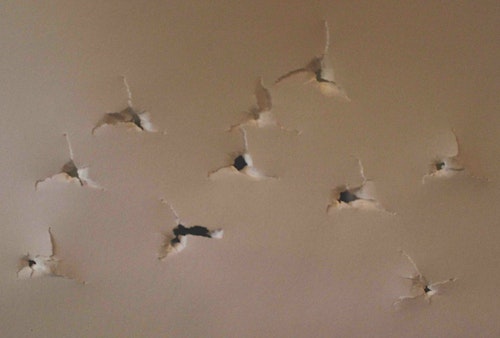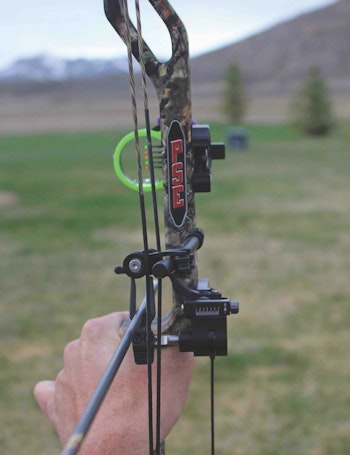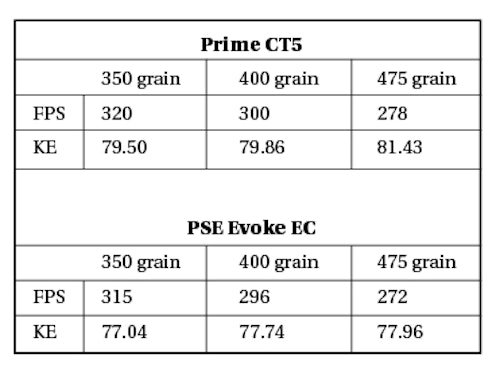Simply put, today’s bows are amazingly engineered to provide top performance in a shootable package well beyond what was previously thought imaginable. The two bows in this review are no exception. Both of these bows are easily tunable, and each comprises features sure to please any bowhunter.
Prime Logic CT5
The 35-inch axle-to-axle Logic CT5 is one of the three models in Prime Archery’s CT series. On board is Prime’s signature parallel cam design, which virtually eliminates cam lean. The cams come with limb stops installed for those who desire a rock solid back wall. For shooters who prefer a more “squishy” back wall, the bows come with cable stops as well. Each CT bow is shipped in the 85 percent letoff setting, but can be easily changed from 70 to 90 percent letoff, simply by moving the position of the draw stop.
The limb pockets have a wide footprint and the limbs themselves are not only wide, but short as well. Because they are so short, Prime had to make the limbs wider to store the energy they wanted for the desired performance and efficiency of the bow.
The riser has a redesigned grip with a nice angle, center flat spot and a taper from bottom to top. Together, these features help to ensure consistent hand placement, which helps improve shot-to-shot consistency. Another thing Prime has done with their grip is placed it at the physical center of the bow. Additionally, over the past few years, Prime has focused on consistent level nock travel and the CT5 is no different. While most bows have more riser above the grip than below, the CT5 grip is in the exact physical center of the bow. Also, it’s easy to see that the top cam is larger than the bottom cam. Together, these two features ensure consistent level nock travel from the beginning of the draw cycle until the arrow leaves the bow.
Another notable feature on the riser of the CT series bows is what they call the “swerve” on the bottom half of the riser. This part of the riser matches the angle of the sight window on the top half of the riser. This helps with the rigidity of the riser and helps to reduce felt vibration on the shot.
The Flexis AR flexing roller guard not only has a great roller system for the cables, but also flexes toward the center of the bow, helping to reduce torque and aid in nock travel. Also aiding in tuning, the Flexis AR can be moved in or out for perfect fletching clearance.
Prime Logic CT5 Specs
- BRACE HEIGHT: 6.5 inches
- AXLE-TO-AXLE: 35 inches
- WEIGHT: 4.5 lbs.
- LETOFF: 70 to 90 percent
- PUBLISHED SPEED: 340 fps
- DRAW WEIGHT: 40, 50, 60, 65, 70 and 80
- DRAW LENGTH: 24.5 to 30 inches
- FINISHES: Tundra, Ghost Green, Morel, Recon Gray, Subalpine, Cipher and Realtree Edge
- MSRP: $999
- CONTACT: www.g5prime.com
Field Testing the Prime Logic CT5
As with all Prime bows, the finish on the CT5 was top notch and the Recon gray makes for a great looking bow, if you prefer a non-camo bow. I quickly tied in a peep and installed the test accessories. Next up was the paper tuner, where with only a few shots I had a nice bullet hole punched in the paper. However, I did have to make a small adjustment toward the riser of the factory center shot setting to get there. It’s worth noting that we perform a field test, rather than utilizing a mechanical shooting device to do the shooting for us. Point being, it could have been a grip issue, but for me this model just had to be a touch inside of center.
One of the first points I noticed was a somewhat stiff, but still manageable draw cycle that broke over into a nice back wall that is rock solid, which is what I prefer. I did notice that although I am usually a 29-inch draw, I felt like a 29.5-inch draw would suit me better in this model. Although the Prime bows are not super lightweight, and this being a slightly longer axle-to-axle bow, when coupled with the solid back wall makes for a super stable bow at full draw. These characteristics really paid off keeping me on target when I was stretching the shots out to 50 and 60 yards.
Vibration was minimal on the shot and the bow seemed quiet while shooting on the outside range. With its ultra-short limbs, I found the CT5 to be more maneuverable than many longer bows, making this bow a great choice for those wanting a longer axle-to-axle bow that is at home in a treestand or ground blind.
PSE Evoke 35 EC
In 2019, PSE archery decided to add three new models to their popular Evolve series. The Evoke 35 EC is one of two 35-inch axle-to-axle offerings in that series. The other is the Evoke 35 SE which has minor specification differences, mainly draw length.
The Evoke series bows feature the Evolve cam system, which is designed with shootability and supreme adjustability in mind. Unlike most of today’s bows that are either draw specific or must have separate modules, draw length adjustments are made by rotating the adjustable mods in half-inch increments. Let-off adjustments from 80 to 90 percent can easily be made on the Evolve cams.
The Evoke limb system has a Wedge-Lock limb pocket system that once your limb is where you desire, you lock it down with a small setscrew to assure they will not move.
Top and bottom cages in the Evoke riser make the riser different from other bows in the Evolve series. This feature has become extremely popular in the industry because the cages help with rigidity and stability and drastically dissipate felt hand shock on the shot.
Like most companies, PSE has been working tirelessly to solve cable guard issues. Their FRS, coupled with their rollerguard is a deadly combination. The Rollerguard has rollers where the cables run, but also has a separate roller that the guard itself runs on up and down. Like the rest of the bow, the FRS is adjustable and aids in bow-tuning. The guard itself flexes toward the center of your bow to help eliminate lateral torque during the draw cycle as well.
PSE Evoke 35 EC Specs
- BRACE HEIGHT: 6.875 inches
- AXLE-TO-AXLE: 35 inches
- WEIGHT: 4.5 lbs.
- LETOFF: 80 to 90 percent
- PUBLISHED SPEED: 320 to 328 fps
- DRAW WEIGHT: 60, 70 and 80
- DRAW LENGTH: 26.5 to 32 inches
- FINISHES: Mossy Oak Country, KUIU Verde, Kryptek Altitude, Realtree Edge, Black, Charcoal, Tan, Platinum and Green Matte
- MSRP: $999 -$1049
- CONTACT: www.pse-archery.com
Field Testing the PSE Evoke 35 EC
Like the Prime, the first thing I noticed right out of the box on the PSE was the finish. Their new Kolorfusion process provides a realistic, vibrant camo finish. With peep installed and accessories bolted on, the paper tune on this bow was a snap. At the factory recommended center shot, I quickly had a bullet hole with minimal adjustments.
Draw cycles are one thing that have been an ever-changing feature and most of today’s bows draw smoothly for performance they deliver. The Evoke 35 EC did not disappoint in this category; its draw cycle was one of the smoothest I have experienced in some time. Once against the wall, it felt like I could hold it forever. This for me can be both a good and bad thing. Being able to hold at full draw comfortably, especially when waiting on that buck of a lifetime to step out can be a lifesaver. However, for me, accurate shooting manifests when I have a little drawn weight to make me pull through the shot. In addition, bows like this can be hard to let down in the field when necessary. Regardless, I do not see this to be an issue and the payoff of the silky smooth draw is worth it.
With the characteristics mapped out above, the Evoke 35 EC proved to be supremely easy to hold on target even at extended distances. Almost dead in the hand on the shot and exceptionally quiet, the Evoke is a pleasure to shoot.
Final Thoughts
Even though both bows were 35-inch axle-to-axle bows, I received a different vibe from each. As I mentioned, the Prime did not seem as “big” in the hand. To me it handled like a much smaller bow, which is nice for making movements while remaining undetected on stand. Couple that with the fact it still has the stable shooting platform of the longer bow and great speed, it’s a good all-around bow. It also had more of the feel of a high-performance speed bow than that of the PSE.
As for the PSE, I just really liked shooting it. It is hard to put your finger on the one thing that makes it so pleasurable to shoot, but all of the little things add up to a topnotch package. Personally, if hunting whitetails from a stand were my only target, I might try out the Evoke 31 EC just to see if the shorter bow was a little more maneuverable. That being said, if you want a bow that is as at home on the whitetail stand as it is on the 3-D course or on a Western hunt, the Evoke 35 EC is a great choice.
How We Test
Each bow is set at a 29-inch draw length and 70 pounds of draw weight. The string is equipped with a RAD 3⁄16-inch peep sight and D-loop. The accessories installed include a Ripcord Lok rest, Black Gold Rush 5-pin sight and a Stokerized stabilizer. Bows are paper tuned and shot through a ProChrono Digital Chronograph, by hand.
Bows are sighted-in from 20 to 60 yards with a 29.5 inch Black Eagle X Impact Arrow, fletched with Vanetec 3-inch vanes and fitted with a 125-grain point for a total weight of 475 grains. All bow work requiring pressing is performed with a Last Chance Archery, EZ Green Press.












